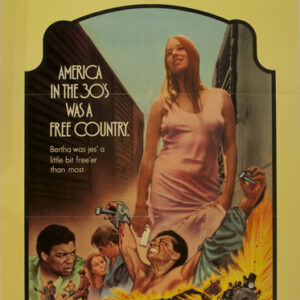calsfoundation@cals.org
Boxcar Bertha
Boxcar Bertha (1972) was the second exploitation film shot in Arkansas by B-movie director Roger Corman. The first was Bloody Mama (1970), and both were set in the 1930s. Corman chose Arkansas because many rural areas in the state could still pass for the Depression-era South. Interiors and street scenes for Bertha were shot around Camden (Ouachita County). Train sequences and other exteriors were shot on the Possum Trot Line of the Reader Railroad in Nevada and Ouachita counties.
Rather than direct the film himself, Corman served as producer and hired a relatively unknown young director, Martin Scorsese, who had impressed Corman with his first feature film, Who’s That Knocking on My Door (1967), also titled I Call First. Corman gave Scorsese a $600,000 budget, a twenty-four-day shooting schedule, and the opportunity to rewrite the script, as long as he kept in the nudity, violence, explosions, and car chases that Corman required for his exploitation formula.
Barbara Hershey stars as the train-hopping title character, and David Carradine stars as her lover, “Big Bill” Shelley, a railroad worker and union organizer. The two fight the railroad and become criminals. Big Bill spends time in prison while Bertha works as a prostitute. They get back together, but the movie ends with railroad goons hanging Big Bill on the side of a boxcar in a symbolic crucifixion scene.
Years later, Scorsese would recall this scene as he shot The Last Temptation of Christ (1988). In fact, Scorsese first got the idea to shoot the later controversial film while in Arkansas. His first exposure to the original novel by Nikos Kazantzakis was on the set of Boxcar Bertha when actress Hershey handed him a copy of the book and suggested he make it into a movie.
Several Arkansans appeared as extras in the film, including Michael G. Fitzgerald, a native of El Dorado (Union County), who later wrote books about the movie industry, including a history of Universal Pictures and Westerns Women: Interviews with 50 Leading Ladies of Movie and Television Westerns from the 1930s to the 1960s (1999).
For additional information:
“Boxcar Bertha.” Internet Movie Database. http://www.imdb.com/title/tt0068309/ (accessed April 6, 2022).
Corman, Roger, with Jim Jerome. How I Made a Hundred Movies in Hollywood and Never Lost a Dime. New York: Random House, 1990.
Gatewood, Margaret Jane. “Remembering Arkansas Movie Mayhem.” Arkansas Democrat-Gazette, April 21, 2013, p. 3H.
LoBrutto, Vincent. Martin Scorsese: A Biography. Westport, CT: Praeger, 2008.
Lybarger, Dan. “Scorsese’s Arkansas Roots: ‘Boxcar Bertha’ at 50.” Arkansas Democrat-Gazette, July 1, 2022, pp. 1E, 6E. Online at https://www.arkansasonline.com/news/2022/jul/01/scorseses-arkansas-roots-boxcar-bertha-at-50/ (accessed July 1, 2022).
Ben Fry
University of Arkansas at Little Rock
 Divergent Prosperity and the Arc of Reform, 1968–2022
Divergent Prosperity and the Arc of Reform, 1968–2022 Fighting Mad
Fighting Mad Hallelujah
Hallelujah Boxcar Bertha
Boxcar Bertha 




Comments
No comments on this entry yet.